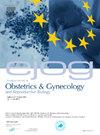The effects of e-health care on health outcomes and psychological distress in patients undergoing assisted reproductive technology: A systematic review and meta-analysis of randomized controlled trials
IF 2.1
4区 医学
Q2 OBSTETRICS & GYNECOLOGY
European journal of obstetrics, gynecology, and reproductive biology
Pub Date : 2025-02-01
DOI:10.1016/j.ejogrb.2024.12.053
引用次数: 0
Abstract
Background
Many studies have reported that electronic health (e-health) care helps health professionals manage patients undergoing assisted reproductive technology (ART) and improves their reproductive outcomes and psychological distress. However, little is known about the effectiveness of e-health care on the health outcomes of patients undergoing ART.
Objectives
This study aimed to evaluate the effectiveness of e-health care on patient-centered health outcomes, such as live birth rate, pregnancy rate, time to pregnancy, etc. as well as psychological distress (i.e., infertility distress and anxiety) among individuals undergoing ART.
Design
A systematic review with random-effects or fixed-effects meta-analysis was conducted to compare e-health interventions with usual care in patients undergoing ART.
Method
Electronic database, including Medline, EMBASE, Web of Science, CINHAL, and CENTRAL, were systematically searched from the inception to December 01, 2023. The authors independently reviewed the articles based on inclusion and exclusion criteria, extracted data, and assessed risk of bias used the Cochrane Risk of Bias tool version 2.0. Heterogeneity was evaluated with I2 and Chi-square. We pooled data from each study using fixed-effects meta-analysis if heterogeneity was low. Random-effects meta-analysis was used to pool data with high heterogeneity. Subgroup analysis (i.e., data collection time point) and sensitivity analysis was performed.
Result
Data were synthesized from 21 articles covering a total of 6,749 participants (female:6,227; male:522). Pooled analysis showed that e-health care may not increase live birth rate (RR 1.44 95 %CI0.78–2.67, P = 0.25). The clinical pregnancy rate was increased to 1.57 times in the e-health care group compared with the control group (Z = 2.19, P = 0.03) and the e-health care group had an increase in time to pregnancy by 17.40 days than that of the control group (Z = 2.13, P = 0.03). Lower score of Fertility Problem Inventory-social subscale was found in the e-health care group. Subgroup analysis showed that the risk ratio of clinical pregnancy was 3.07 (95 %CI 1.60–5.89) in < 3 months group, 1.21 (95 %CI 0.93–1.59) in ≥3 months group. The fertility-related knowledge level in e-health group was higher than that of the control group (Z = 2.01, P = 0.04).
Conclusion
Low certainty evidence suggests that e-health care increases the clinical pregnancy rate after the intervention. Additionally, e-health care benefits in improving perceived infertility-related stress specific to social and the level of infertility-related knowledge. Future studies are needed to establish core outcome measures for e-health intervention targeting infertile individuals.
电子医疗保健对接受辅助生殖技术的患者的健康结果和心理困扰的影响:随机对照试验的系统回顾和荟萃分析。
背景:许多研究报告称,电子卫生保健(e-health)有助于卫生专业人员管理接受辅助生殖技术(ART)的患者,并改善其生殖结果和心理困扰。然而,人们对电子医疗保健对接受抗逆转录病毒治疗的患者的健康结果的有效性知之甚少。目的:本研究旨在评估电子卫生保健对接受抗逆转录病毒治疗的个体的以患者为中心的健康结局(如活产率、怀孕率、怀孕时间等)以及心理困扰(即不孕困扰和焦虑)的有效性。设计:进行随机效应或固定效应荟萃分析的系统评价,比较接受抗逆转录病毒治疗的患者的电子卫生干预与常规护理。方法:系统检索Medline、EMBASE、Web of Science、CINHAL、CENTRAL等自建库至2023年12月1日的电子数据库。作者根据纳入和排除标准独立审查文章,提取数据,并使用Cochrane风险偏倚工具2.0版评估偏倚风险。异质性评价采用I2和卡方分析。如果异质性较低,我们使用固定效应荟萃分析汇总每项研究的数据。随机效应荟萃分析用于汇集具有高异质性的数据。进行亚组分析(即数据收集时间点)和敏感性分析。结果:数据由21篇文章合成,共涵盖6749名参与者(女性:6227名;男:522)。合并分析显示,电子医疗保健可能不会提高活产率(RR 1.44 95% CI0.78-2.67, P = 0.25)。电子保健组的临床妊娠率比对照组提高了1.57倍(Z = 2.19, P = 0.03),电子保健组的妊娠时间比对照组增加了17.40天(Z = 2.13, P = 0.03)。生育问题量表-社会分量表得分在电子医疗保健组较低。亚组分析显示,临床妊娠风险比为3.07 (95% CI 1.60 ~ 5.89)。结论:低确定性证据提示电子医疗干预后提高了临床妊娠率。此外,电子医疗保健有助于改善与不孕症有关的社会压力和与不孕症有关的知识水平。未来的研究需要建立针对不孕症个体的电子卫生干预的核心结果措施。
本文章由计算机程序翻译,如有差异,请以英文原文为准。
求助全文
约1分钟内获得全文
求助全文
来源期刊
CiteScore
4.60
自引率
3.80%
发文量
898
审稿时长
8.3 weeks
期刊介绍:
The European Journal of Obstetrics & Gynecology and Reproductive Biology is the leading general clinical journal covering the continent. It publishes peer reviewed original research articles, as well as a wide range of news, book reviews, biographical, historical and educational articles and a lively correspondence section. Fields covered include obstetrics, prenatal diagnosis, maternal-fetal medicine, perinatology, general gynecology, gynecologic oncology, uro-gynecology, reproductive medicine, infertility, reproductive endocrinology, sexual medicine and reproductive ethics. The European Journal of Obstetrics & Gynecology and Reproductive Biology provides a forum for scientific and clinical professional communication in obstetrics and gynecology throughout Europe and the world.

 求助内容:
求助内容: 应助结果提醒方式:
应助结果提醒方式:


